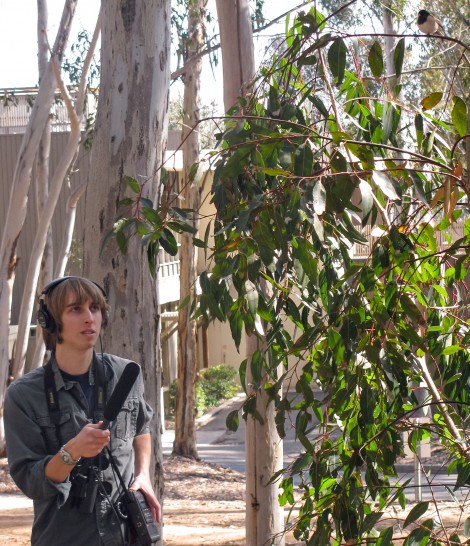
The Significance of Female Birdsong
Ohio Wesleyan Professor, Students Publish Research in Journal of Avian Biology
DELAWARE, Ohio – Three Ohio Wesleyan University scientists – one professor and two students – have published new research in the Journal of Avian Biology exploring the meaning of female sparrows in the wild singing male-like songs.
Their article, titled “Female Dark-eyed Juncos (Junco hyemalis thurberi) produce male-like song in a territorial context during the early breeding season,” appears in the latest edition of the peer-reviewed, bimonthly journal, widely considered one of the leading scientific publications of ornithological research.
Sharing first-, second-, and third-author credits on the article are Dustin Reichard, Ph.D., Ohio Wesleyan assistant professor of zoology, and OWU students Daniel Brothers and Serena George.
For the research, Brothers, a junior from Fort Wayne, Indiana, and George, a junior from Palos Park, Illinois, analyzed a selection of different recorded songs sung by the Dark-eyed Junco, a small, grayish American sparrow.
“We both went about it without knowing whether it was a male or a female (song) we were listening to,” said Brothers, a double-major in zoology and theatre. “This was to prevent observer bias.”
During the writing of the now-published paper, Brothers said, “I put in a few personal observations I had, and I put some thought into whatever questions Dr. Reichard posed when he was writing the bulk of the paper.”
Their findings already have been the subject of an article in The New Scientist, “Female birds that used to be silent are now singing like males.”
Reichard, who joined the Ohio Wesleyan faculty in 2015, said to obtain the song samples, the researchers presented 17 free-living junco pairs with a live, caged female early in the breeding season. Three females responded by diving at the intruding female, chasing their male mates, fanning their tail feathers, and singing a trilled song similar to male long-range song.
“Both the seasonal and social context in which these songs were observed suggest a potential function for female song in mate guarding and polygyny prevention,” Reichard explained, “but more data are needed to test this hypothesis. Whether female song is common in all Dark-eyed Juncos during the early breeding season or if it is restricted to this particular urban and non-migratory population remains an important question for future research.”
Broadly speaking, Reichard focuses his research on the evolution of animal communication and sexual selection with a particular emphasis on birds. More specifically, he studies “the relationship between signal structure and function in a variety of poorly understood signals, including whispered vocalizations, that function in aggression and courtship as well as female songs.”
“How effectively each individual produces these different sounds in various social contexts has a direct effect on its fitness and survival,” he said.
This latest research also includes two authors – Jonathan Atwell, Ph.D., and Ellen Ketterson, Ph.D. – from Indiana University, where Reichard earned his doctorate. Learn more about Reichard and Ohio Wesleyan’s Department of Zoology at www.owu.edu.
Founded in 1842, Ohio Wesleyan University is one of the nation’s premier liberal arts universities. Located in Delaware, Ohio, the private university offers more than 90 undergraduate majors and competes in 23 NCAA Division III varsity sports. Through Ohio Wesleyan’s signature OWU Connection program, students integrate knowledge across disciplines, build a diverse and global perspective, and apply their knowledge in real-world settings. Ohio Wesleyan is featured in the book “Colleges That Change Lives” and included in the U.S. News & World Report and Princeton Review “best colleges” lists. Learn more at www.owu.edu.
